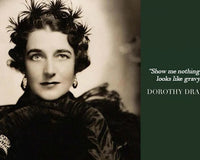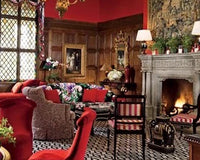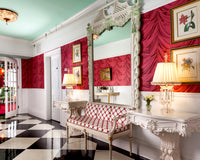You might call it the best, biggest penthouse in Texas.
In 1936 Colonel Harry E. Stewart, then owner of Dallas's elegant Stoneleigh Court hotel (at 11 floors, the tallest game in town), asked renowned decorator Dorothy Draper to help him give Texas the one thing it desperately needed: a penthouse—the first in the state. She agreed and "set about creating a Scottish mansion in the sky," says Carleton Varney, president of Dorothy Draper Company, featuring ornate plaster ceilings, marble floors and 500-year-old English oak paneling. When finished, the 7,200-square-foot penthouse (made by combining a ballroom and a dining area) had morphed into a duplex, thanks to Stewart's decision to add a 12th floor boasting a terrace overlooking all of "Big D." Not surprisingly, Stewart (who'd made a bundle selling Ford farm equipment) was its first inhabitant, living in his creation until 1943, when he sold the hotel.
Three years ago Draper's sensibility was again called upon when Prescott Realty Group and Apollo Real Estate Advisors—the current owners of the (renamed) Stoneleigh Hotel Spa—asked Varney if he could restore the penthouse to its former glory, thus beginning "the rehab of Colonel Stewart's digs and a love affair between us," says Varney. Advertisement
"Basically, though the wood and even the secret passages were still there, nothing had been done to the space since the '40s," explains Jud Pankey, CEO of Prescott Realty Group. "Before Carleton could do anything with fabrics and soft goods, we had to restore the wood, add walls, all the stuff you do to a landmark building—in short, reinvent the space within the original bones."
And what lovely bones they are. Sitting atop the hotel's 170 rooms (also updated as part of the Stoneleigh's recent $36 million face-lift), the duplex penthouse contains three bedroom suites, a picture gallery, a dining room, a living room, a library and bar and seven baths. A staircase leads to the 12th floor, meanwhile, which features a terrace and a Chinese-style parlor. "The colonel and Mrs. Draper put in the round window and built the pagoda top," explains Varney, "because the colonel, who traveled a lot, needed a space for his artifacts. The place was filled with statues, paintings and overcarved furniture. Once he sold it, however, over the years everything deteriorated. People came in and painted everything white."
It was under that paint that Peter Goodchild, who restored the space's hardwood, unearthed, along the walls of the picture gallery, a couple of terrific surprises: two 18th-century mirrors "covered over with 30 years of paint," says Pankey. "We had no idea there was gold leaf underneath. Peter called and said, Better come over now. You're going to want to make sure your insurance policy covers these.'
"I said, Come on!' And he said, I'm serious. These are the oldest pieces in the entire hotel. If you want me to restore them, I will; it's costly, but they're spectacular.'"
Indeed. Today, restored and resplendent, the mirrors grace the picture gallery once more, offering a dazzling opening salvo to this amazing space, with its glamorous history of star-studded overnight occupants like Katharine Hepburn. Its longest-running resident, Hard Rock Cafe titan Isaac Tigrett, camped out for two years while building the Dallas Hard Rock. "When Isaac was here," recalls Pankey, "Yoko Ono and Dan Aykroyd painted a mural in the master bath that some knucklehead general manager painted over. Can you imagine?" Varney cannot. "I'd love to still have that mural," he laments. WATCH Inside the $23M Duplex Penthouse From "Succession" Advertisement
"We embraced Carleton's vision," says Pankey. "He wanted what we did—something over the top and elegant that people, while remembering the old Stoneleigh, would also see had been transformed into something not available in either a house or another hotel—that is, a palace."
À la Draper, of course, albeit "the new Dorothy, the millennial Dorothy," chuckles Varney, who worked with his colleagues Sara Beaudry and Daniel Parker on the project. "What we did was take elements of what Mrs. D. would've done had it been 2008 instead of 1936." Thus, though modernized, the penthouse includes such updated staples as the Dorotheum sofa, covered in a Greenbrier chintz, and the slipper chairs from the Fairmont.
Another Draper signature is the zesty use of color throughout both floors, like the red accents in the Chinese-motif parlor. "Mrs. Draper used to walk around the office, hands over head, checking everybody's work, their color choices, saying, No gravy,' " laughs Varney. " Show me no gravy.' "
Now that the colonel's flat is back and even better, its owners are thrilled with the results—aesthetically and historically. "On the one hand, we think it's beautiful," says Pankey. "And on the other, when you understand what Dorothy Draper did for design and women in the field, it's a great story. We won on both counts.
"In our heart of hearts we know that someone is going to offer to buy the penthouse," he admits, "but it's not for sale. This thing is just too much fun."










